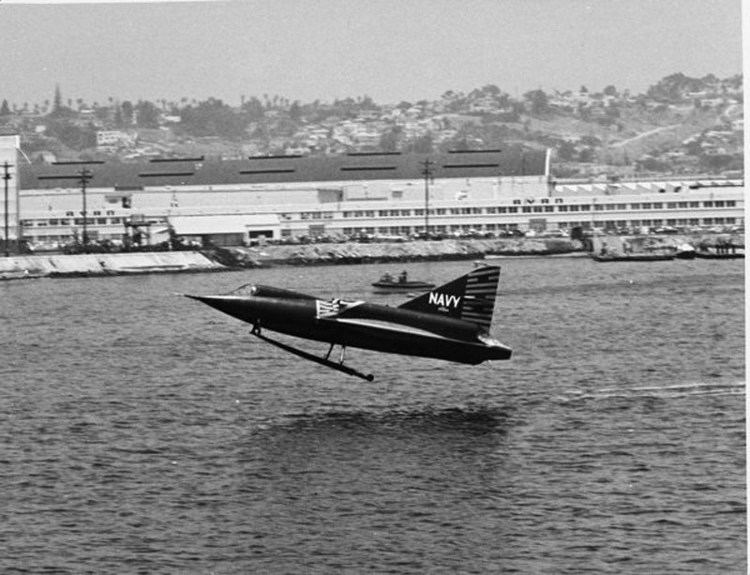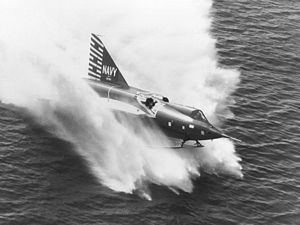Top speed 1,328 km/h Wingspan 10 m Weight 5,730 kg First flight January 14, 1953 | Range 826 km Length 16 m | |
Convair f2y sea dart
The Convair F2Y Sea Dart was a unique American seaplane fighter aircraft that rode on twin hydro-skis for takeoff. It flew only as a prototype, and never entered production. It is the only seaplane to have exceeded the speed of sound.
Contents
- Convair f2y sea dart
- Ksp history s misfits s2e5 convair f2y sea dart
- Development
- Design
- Ski configurations
- Submarine carriage
- Operational history
- Redesignation
- In popular culture
- Operators
- Aircraft on display
- Specifications F2Y 1
- References

Ksp history s misfits s2e5 convair f2y sea dart
Development
The Sea Dart began as Convair's entry to a 1948 U.S. Navy contest for a supersonic interceptor aircraft. There was at the time much skepticism about operating supersonic aircraft from aircraft carrier decks, which explains why the U.S. Navy ordered so many subsonic fighters at that time. The worry had some foundation, since many supersonic designs of the time required long takeoff rolls, had high approach speeds and were not very stable or easy to control - all factors that were troublesome on a carrier.
Ernest Stout's team at Convair's hydrodynamic research laboratory proposed to put a Delta Dagger on water skis.
Convair's proposal gained an order for two prototypes in late 1951. Twelve production aircraft were ordered before a prototype had even flown. No armament was ever fitted to any Sea Dart built, but the plan was to arm the production aircraft with four 20mm Colt Mk12 cannon and a battery of folding-fin unguided rockets. Four of this order were redesignated as service test vehicles, and an additional eight production aircraft were soon ordered as well.
Design

The aircraft was to be a delta-winged fighter with a watertight hull and twin retractable hydro-skis for takeoff and landing. When stationary or moving slowly in the water, the Sea Dart floated with the trailing edge of the wings touching the water. The skis were not extended until the aircraft reached about 10 mph (16 km/h) during its takeoff run.

Power was to be by a pair of afterburning Westinghouse XJ46-WE-02 turbojets, fed from intakes mounted high above the wings to avoid ingesting spray. When these engines were not ready for the prototypes, twin Westinghouse J34-WE-32 engines of just over half the power were installed.
Ski configurations
The prototype was fitted with an experimental single ski, which proved more successful than the twin-ski design of the second service test aircraft. Testing with several other experimental ski configurations continued with the prototype through 1957, after which it was placed into storage.
The aerodynamic stability of the long, narrow, single-surface ski did not go unnoticed by aircraft designers, leading to the placement of a speed brake of similar configuration on the top of the McDonnell Douglas F-15 fighter.
The US was not the only country to consider the hydroski. The Saunders-Roe company of the United Kingdom, which had already built an experimental flying boat jet fighter,first flying in 1947 the SR.A/1, tendered a design for a ski-equipped fighter but little came of it.
Submarine carriage
In the 1950s, the US Navy considered the internal arrangements of a submarine aircraft carrier that could carry three of these aircraft. Stored in pressure chambers that would not protrude from the hull, they would be raised by a portside elevator just aft the sail and set to take off on their own on a smooth sea but catapulted aft in a higher sea. The program only reached the "writing on a napkin" stage, for two problems were not addressed: the hole for the elevator would have seriously weakened the hull and the load of a laden elevator would also be difficult to transmit to the hull structure.
Operational history
The aircraft was built in Convair's San Diego facility at Lindbergh Field and was taken to San Diego Bay for testing in December 1952. On 14 January 1953, the aircraft with E. D. "Sam" Shannon at the controls, inadvertently made its first short flight during what was supposed to be a fast taxi run; its official maiden flight was on 9 April.
The underpowered engines made the fighter sluggish, and the hydro-skis were not as successful as hoped; they created violent vibration during takeoff and landing, despite the shock-absorbing oleo legs they were extended on. Work on the skis and oleo legs improved this situation somewhat, but they could not cure the sluggish performance. The Sea Dart proved incapable of supersonic speed in level flight with the J34 engines; not helping was its pre-area rule shape, which meant higher transonic drag.
The second prototype was cancelled, so the first service test aircraft was built and flown. This was fitted with the J46 engines, which performed below specification. However, speeds in excess of Mach 1 were attained in a shallow dive with this aircraft, making it the only supersonic seaplane to date. On 4 November 1954, Sea Dart, BuNo 135762 disintegrated in midair over San Diego Bay during a demonstration for Navy officials and the press, killing Convair test pilot Charles E. Richbourg when he inadvertently exceeded the airframe limitations. Richbourg was a 31-year-old Navy veteran of the Second World War. He was quickly pulled from the water but did not survive the breakup of the airframe. He is buried in Saint Augustine National Cemetery in Florida.
Even before that, the Navy had been losing interest (problems with supersonic fighters on carrier decks having been overcome) and the crash relegated the Sea Dart program to experimental status. All production aircraft were cancelled, though the remaining three service test examples were completed. The two final prototypes never flew.
Redesignation
Despite the fact that the airplane was officially retired and had not flown since 1957, at least one F2Y was still in storage as of 1962. As a result, it was redesignated YF-7A under the 1962 United States Tri-Service aircraft designation system.
In popular culture
The pilot episode of the television series Sea Hunt features footage of the F2Y in flight and riding on the hydro-skis.
Operators
Aircraft on display
All four remaining Sea Darts survive to this day.
Specifications (F2Y-1)
General characteristics
Performance (estimated)
Armament
